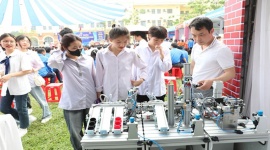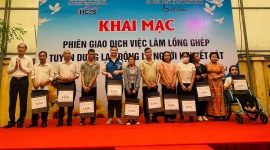Vietnam launches second programme of action plan to tackle child labour
(LĐXH)- The second Programme on the Prevention and Reduction of Child Labour for the 2021 ̶ 2025 period was launched in Hanoi on 1 December 2021.
The event was attended by around 300 online and offline participants, including representatives from government ministries, the US Embassy and the EU, academic and research institutions, workers’ and employers’ organizations, UN agencies, NGOs, industry associations and enterprises, and provincial level implementing agencies.
During the event, participants were introduced to the objectives and content of the programme, and provided with guidance on how to translate these aims into concrete action. 
Illustrative image

Approved by the Prime Minister through Decision No. 782/QD - TTg on 27 May 2021, the programme was developed and launched by the Ministry of Labour, Invalids and Social Affairs (MoLISA) in collaboration with related departments and ministries, with technical support from the International Labour Organization (ILO) and the United Nations Children Fund (UNICEF).
With a long-term vision towards 2030, the programme has three core aims: to prevent and detect cases of child labour, and support and provide interventions for children engaged in and at risk of child labour; to raise awareness on child labour prevention and reduction; and to deliver training and capacity building on child labour prevention and reduction.
The content of the programme builds on the successes and lessons learned from the implementation of the first National Child Labour Programme, implemented from 2016 ̶ 2020.
The first programme was coordinated and supported by a variety of ministries, sectors, provinces and international organizations, resulting in enhanced capacity to implement child labour prevention and reduction at all levels and among multiple sectors, with targeted interventions and support provided to children and their families across the country.
Moreover, the legal system on child labour has been strengthened, with child labour prevention and reduction rising on the policy agenda, resulting in the mobilization of Party committees, authorities, ministries, mass organizations, businesses and society as a whole.
Through the launch of the second national child labour programme, the goal is to step up these efforts, in line with Viet Nam’s commitments as a pathfinder country for Global Alliance 8.7 ̶ a multistakeholder partnership to eliminate child labour in line with sustainable development goal (SDG) target 8.7 to eliminate child labour. As such, the upcoming programme is aligned with Viet Nam’s Road Map towards SDG Target 8.7.
In order to achieve this target, more work is needed. According to ILO estimates, by 2020 160 million children worldwide were participating in child labour. As a result of COVID-19, this figure is predicted to increase by 8.9 million (rising to 168.9 million) by 2022.
In Viet Nam, according to the results of the 2018 National Child Labour Survey, 1,031,944 children aged 5-17 ̶ accounting for 5.4 per cent of children in this age group ̶ were in child labour.
The rate of child labour in Vietnam is almost 2 percentage points lower than the average Asia Pacific rate, and over 4 percentage points lower than the global average. However, as global estimates suggest, unless urgent action, these figures will rise as a result of the global pandemic.
Addressing the launch event, ILO specialist Bharati Pflug emphasized: “Vietnam has committed to comply with international labour standards, including the eradication of child labour, as required by new-generation Free Trade Agreements. The implementation of the National Programme will ensure that this commitment is applied in practice, facilitating Viet Nam’s full integration into the global economy; this is crucial to the country’s economic recovery from COVID-19”.
In her remarks at the event, Ms Nguyen Thi Ha, Deputy Minister of MoLISA, emphasized that: "Ministries, unions, localities and organizations must actively develop plans and solutions to better prevent and reduce child labour in line with their respective responsibilities. We must also continue to implement policies to support employees facing difficulties in the context of COVID-19, in line with Resolutions No. 68 and No. 126”.
She also stressed the need to connect the child labour programme with other target programmes, namely the National Programme on Poverty Reduction and Social Security; the National Programme on Sustainable Poverty Reduction; the National Programme on Rural Development; and the National Programme for Socio-economic Development in Ethnic Minority and Mountainous areas./.
Hong Anh
-
 Minister Dao Ngoc Dung received the ASEAN’s General Secretary
24-04-2024 10:38 35
Minister Dao Ngoc Dung received the ASEAN’s General Secretary
24-04-2024 10:38 35 -
 Ha Nam province promotes career orientation for students
23-04-2024 14:28 49
Ha Nam province promotes career orientation for students
23-04-2024 14:28 49 -
 Hundreds of job opportunities for people with disabilities in Hanoi
17-04-2024 10:22 29
Hundreds of job opportunities for people with disabilities in Hanoi
17-04-2024 10:22 29
-
 Minister Dao Ngoc Dung received the Chairman of the Korea International Cooperation Agency
21-03-2024 14:14 48
Minister Dao Ngoc Dung received the Chairman of the Korea International Cooperation Agency
21-03-2024 14:14 48 -
 MoLISA proposing Japan to expand occupations to receive Vietnamese workers
18-03-2024 11:12 55
MoLISA proposing Japan to expand occupations to receive Vietnamese workers
18-03-2024 11:12 55 -
 Promote labour relations between Vietnam and Hungary
18-03-2024 09:55 15
Promote labour relations between Vietnam and Hungary
18-03-2024 09:55 15
English Review


Minister Dao Ngoc Dung received the ASEAN’s General Secretary
English Review | 24-04-2024 10:38 35







